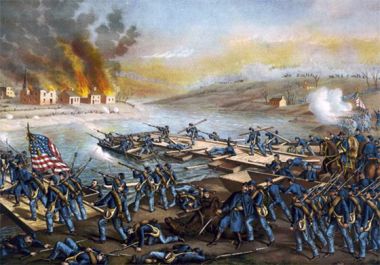 Delayed for nearly a month, Union Commander Ambrose Burnside finally launches his plan to cross the Rappahannock River, drive the Confederates from Fredericksburg, Virginia, and proceed south to Richmond. The first step of his plan requires the army engineers to construct pontoon bridges because the river is too wide and too deep to ford. In the early morning hours of December 11, the engineers begin their perilous work.
Delayed for nearly a month, Union Commander Ambrose Burnside finally launches his plan to cross the Rappahannock River, drive the Confederates from Fredericksburg, Virginia, and proceed south to Richmond. The first step of his plan requires the army engineers to construct pontoon bridges because the river is too wide and too deep to ford. In the early morning hours of December 11, the engineers begin their perilous work.
As the first timid rays of a foggy dawn begin to flicker across the skyline, the engineers remain invisible to the Confederate soldiers under the command of General William Barksdale, who are secreted in the cellars and buildings situated on the far river bank. However, by mid-morning the strengthening sun burns away the protective fog, and the Confederates, witnessing the bridges stretching toward them, unleash a powerful defense of musket fire. The overwhelming fire forces the engineers to suspend their work and retreat back to the shore. Covering fire by Federal infantry stationed along the riverbank fails to suppress the Confederate fusillade. In desperation, Burnside orders his artillery to bombard the city, hoping to drive the defenders away from the river.
The barrage inflicts tremendous damage on the city. Some homes and businesses are completely destroyed, others burn, and nearly all buildings suffer some level of damage. Watching from one of the artillery positions, a Federal soldier observed, “We could see the boards and brick fly as the shells went dashing through the buildings which soon began to present a sorry look.” Another wrote, “It was a great amusement to us to watch a solid shot tear through a building, beat down a wall, topple over a chimney or root out a nest of sharpshooters.”
Situated on a plateau just two blocks from the river, the Fredericksburg Baptist Church is not spared. Artillery rounds pierce the façade and at least seven shells penetrate the roof. Plaster from the interior walls and shattered glass from the windows litter the sanctuary. The home of William F. Broaddus, the pastor, fares no better. Located just a block away from the church, his house is also hit, suffering damage so extensive Broaddus and his family are forced to flee to Charlottesville, Virginia, where they remain for the duration of the war. The home of Joseph Alsop–probably the wealthiest member of the Baptist Church–is located just a few doors down from Broaddus’. Having fled from the city before the onset of the battle, his daughter, Lizzie, recorded in her diary upon her return two weeks later, “Well, I have been over the house and find destruction less than I had anticipated, true, almost every room has a ball through it and the garden is very much torn to pieces…”
This devastating demonstration of the power of the Federal artillery is only the opening act in a play that will now consume Fredericksburg for the next three days. Following the initial artillery barrage, Federal troops begin their occupation of Fredericksburg, pushing back the Confederates in desperate street fighting, in the process inflicting even more damage on the hapless city. As night falls, the Confederates withdraw to their defenses just outside the western edge of Fredericksburg and thousands of Federal troops begin crossing the bridges and pouring into the city. As the opening act of this martial drama concludes, the stage is set for even more tragedy over the next several days.
Sources: Francis Augustin O’Reilly, The Fredericksburg Campaign: Winter War on the Rappahannock, Louisiana State University Press, 2003; “Diary of Lizzie Alsop,” National Park Service, unpublished; image, Frank Leslie, “The Forlorn Hope” (link)
Article written by Dennis Sacrey, President of the Virginia Baptist Historical Society, and Church Administrator, Fredericksburg Baptist Church


